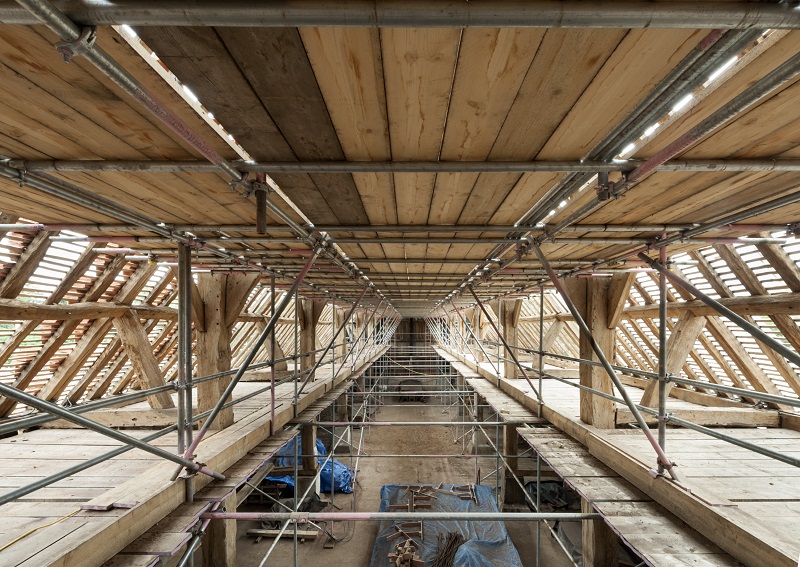Find Reliable Scaffolding Services in Surrey for Your Project Needs
Find Reliable Scaffolding Services in Surrey for Your Project Needs
Blog Article
Checking Out the Different Kinds Of Scaffolding Utilized in Construction Tasks
The building and construction industry counts heavily on various kinds of scaffolding to meet certain task requirements, each offering distinct benefits and applications. Typical framework scaffolding gives a durable structure for general tasks, while put on hold scaffolding is necessary for work on high-rise structures.

Conventional Framework Scaffolding
Standard structure scaffolding is just one of one of the most extensively utilized techniques in the building and construction sector because of its effectiveness and convenience. This system includes horizontal and upright frames that are put together to create a stable system for employees and materials. The primary components consist of upright articles, horizontal journals, and diagonal braces, which with each other supply a strong structure that can support substantial tons.
Among the crucial advantages of typical framework scaffolding is its adaptability to numerous building and construction projects, varying from domestic structures to large industrial frameworks. The modular design permits easy setting up and disassembly, making it efficient for both temporary and long-term jobs. Additionally, the system can be personalized in height and size, fitting various building layouts and website conditions.
Security is extremely important in scaffolding applications, and conventional frame systems are outfitted with guardrails and toe boards to protect against falls and make certain employee defense. Routine assessments and adherence to safety and security regulations are important in preserving the honesty of the scaffold (Scaffolding). On the whole, traditional structure scaffolding remains an essential option in the building market, supplying a reliable platform for labor and enhancing overall project efficiency

Suspended Scaffolding
Suspended scaffolding provides a distinct remedy for construction jobs that call for accessibility to elevated surface areas, specifically in scenarios where typical structure scaffolding may be impractical. This sort of scaffolding is commonly suspended from the roof or top levels of a framework, using a system of sheaves, ropes, and systems to create a functioning area that can be readjusted to various heights.
One of the main advantages of suspended scaffolding is its flexibility. It can be quickly rearranged or reduced to suit modifications in building demands, making it excellent for jobs such as window installment, façade job, and maintenance on skyscrapers. Furthermore, the marginal impact of suspended scaffolding permits far better use of ground area in metropolitan environments, where area is frequently minimal.
Safety is a crucial consideration in the usage of suspended scaffolding. Overall, suspended scaffolding provides a efficient and effective option for accessing hard-to-reach locations in different building and construction circumstances, boosting both efficiency and security on site.
System Scaffolding
System scaffolding, commonly pertained to as a modern-day remedy in the scaffolding sector, is composed of pre-engineered elements that can be swiftly set up and adapted for various construction projects. Scaffolding. This sort of scaffolding is identified by its modular layout, which enables for adaptability and effectiveness on work sites, fitting architectural demands and different heights
Typically made from high-strength steel or light weight aluminum, system scaffolding uses enhanced resilience and stability. The components consist of upright posts, straight ledgers, and angled braces, which adjoin safely, guaranteeing a durable structure. The design often includes standard fittings, streamlining setting up and disassembly procedures, therefore minimizing labor time and costs.

Rolling Scaffolding
Rolling scaffolding is a flexible option to conventional fixed scaffolding, designed for mobility and ease of usage on construction websites. This kind of scaffolding includes a system supported by frames with wheels, allowing workers to conveniently transfer it as required. The wheelchair function dramatically boosts performance, as it decreases downtime associated with taking apart and putting together fixed scaffolding.
Generally constructed from light-weight materials such as light weight aluminum or steel, rolling scaffolding supplies a strong yet portable service for projects requiring regular repositioning - Scaffolding. It is especially advantageous in jobs such as painting, drywall installation, and electrical work, where accessibility to numerous elevations and areas is needed
Security is paramount their explanation in rolling scaffolding layout, with functions such as securing wheels to avoid unintended activity when in use, and guardrails to shield workers from drops. Additionally, many designs are adjustable in elevation, fitting various task requirements.
Cantilever Scaffolding

The style of cantilever scaffolding commonly entails utilizing arms or brackets anchored to a structure or structure, allowing the platform to prolong external safely. Safety and security is critical; hence, these scaffolds need to be crafted to stand up to different lots and environmental conditions. Normal examination and upkeep are important to make sure architectural stability and worker safety.
Cantilever scaffolding is favored for its convenience and efficient use area, making it a popular choice in city settings where space constraints prevail. Furthermore, it promotes simpler access to high altitudes, eventually adding to the overall effectiveness of construction projects. As with all scaffolding types, proper training and adherence to safety and security criteria are essential for workers using cantilever scaffolding.
Final Thought
In conclusion, the diverse kinds of scaffolding made use of in construction projects each offer distinctive purposes customized to specific site needs. Conventional structure scaffolding gives security, while put on hold scaffolding offers flexibility for raised jobs. System scaffolding assists in fast setting up, and rolling scaffolding improves mobility for varying workplace. Cantilever scaffolding properly attends to scaffolding vygotskij obstacles in metropolitan settings. Comprehending these scaffolding kinds is vital for enhancing security and performance in building, eventually adding to the effective conclusion of jobs.
Standard structure scaffolding offers a tough foundation for general tasks, while put on hold scaffolding is necessary for job on high-rise structures.Rolling scaffolding is a functional alternative to conventional fixed scaffolding, created for flexibility and simplicity of usage on building websites. As with all scaffolding types, proper training and adherence a fantastic read to safety and security criteria are important for employees making use of cantilever scaffolding.
Traditional structure scaffolding provides security, while put on hold scaffolding provides convenience for elevated jobs. System scaffolding facilitates fast assembly, and rolling scaffolding improves mobility for differing job settings.
Report this page